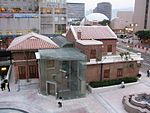Hong Kong Museum of Art
1962 establishments in Hong KongArt museums and galleries in Hong KongArt museums established in 1962Asian art museumsEngvarB from May 2013 ... and 1 more
Tsim Sha Tsui

The Hong Kong Museum of Art (HKMoA) is the first and main art museum of Hong Kong, located in Salisbury Road, Tsim Sha Tsui. It is managed by the Leisure and Cultural Services Department of the Hong Kong Government. HKMoA has an art collection of over 17,000 items. Admission is free for permanent exhibitions. Its rival is the non-government-managed Hong Kong Arts Centre. These two museums are considered to be the top two art museums in Hong Kong that dictate the discourse of art in Hong Kong.It has a extended branch, the Flagstaff House Museum of Tea Ware, at the Hong Kong Park in Central.
Excerpt from the Wikipedia article Hong Kong Museum of Art (License: CC BY-SA 3.0, Authors, Images).Hong Kong Museum of Art
Kowloon Tsim Sha Tsui (Yau Tsim Mong District)
Geographical coordinates (GPS) Address Nearby Places Show on map
Geographical coordinates (GPS)
| Latitude | Longitude |
|---|---|
| N 22.293547222222 ° | E 114.172025 ° |
Address
Kowloon, Tsim Sha Tsui (Yau Tsim Mong District)
Hong Kong, China
Open on Google Maps











